More than 40 years ago, I took a photojournalism course from one of the all-time worlds greatest, W. Eugene Smith. He gave the class an assignment; photograph your neighborhood.
 This is the opening picture of my essay on Staten Island, looking east on Forest Ave. from Hoyt Ave.
This is the opening picture of my essay on Staten Island, looking east on Forest Ave. from Hoyt Ave.The assignment was based, in part on his “Dream Street: W. Eugene Smith's Pittsburgh Project,” and a personal project of pictures of the building where his loft was located. He made a series of photographs, published in Life magazine including what was seen out of his window. Smith’s early work on the Pittsburgh Project came to a bad end when his negatives of the better part of a year’s worth of work were stolen in an auto burglary.
Smith received a Guggenheim Grant and completed the two-year long photo essay.
The man had some obsessions and wanted to pass them on. When I moved into the house I now own, I revisited Smith’s obsession. I have been taking pictures of activity in the park across the street for years. There is a lot of varied activities: folk dancers, picnics, school outings, sports ranging from five-year old soccer practice, to para-gliders, to university runners.
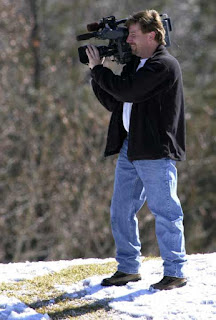 When it snows, the hill is worn bare by the tobogganors and makeshift sleds made from cardboard boxes. This KOB TV photographer shoots his kids in the park.
When it snows, the hill is worn bare by the tobogganors and makeshift sleds made from cardboard boxes. This KOB TV photographer shoots his kids in the park.Then there are the film productions. I’ve photographed Diane Denish and her husband Herb and a daughter making a TV ad for her 2002 run for Lieutenant Governor. And the Cialis commercial with a man and woman running through the park and the man jumping in the air off a mini trampoline…
My current personal project, “From My Porch,” is a work in progress. I’ve used a few images on this site. I don’t know if I will ever compile a collection for general viewing, but it is continuously interesting, watching the world go by.
The other day I was photographing activity in the park and got called Paparazzi.
So what’s wrong with this picture?
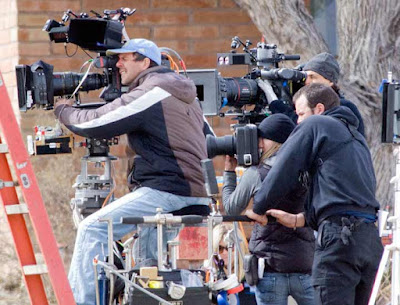 This is a story about State tax credits. Confused? So am I.
This is a story about State tax credits. Confused? So am I.There are a few Hollywood theories that help inform this post.
You must have a suspension of disbelief to accept what you see on the screen.A band of gypsies took over my neighborhood.
It started with a man wandering the street. The cop in me said he was out of place and looking for an accomplice. I was right and wrong at the same instance. He was looking for his accomplices; they just weren’t up to anything criminal. They were an advance element of electricians setting up a temporary electric system.
It was the production crew of the locally filmed television show, In Plain Sight, seen on the USA Network.
 They brought a bunch of trailers and parked in the local church’s parking lot.
They brought a bunch of trailers and parked in the local church’s parking lot.The streets were blocked off by three off duty police officers working what is known as Chief’s overtime, $42 an hour, paid for by the film company.
There was a playground swing set in the corner of the park across the street from a recently remodeled house that has a spectacular view of the Sandia Mountains. The house was being used as part of the set for interior and exterior shots.
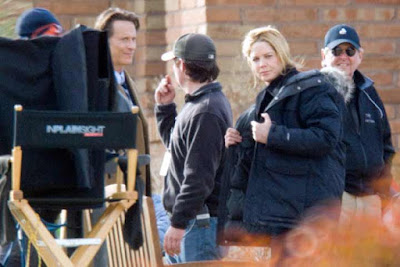 Actress Mary McCormack, above, plays US Marshal Mary Shannon with Actor Frederick Weller, below, playing her partner, US Marshal Marshall Mann.
Actress Mary McCormack, above, plays US Marshal Mary Shannon with Actor Frederick Weller, below, playing her partner, US Marshal Marshall Mann.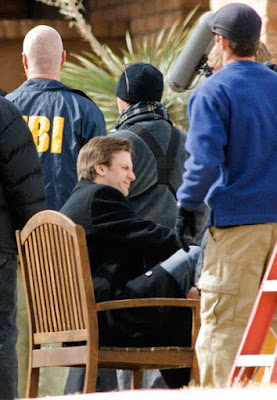 I got out my long lens that I use to photograph birds and sports and things that are a long ways away and took pictures of the filming process.
I got out my long lens that I use to photograph birds and sports and things that are a long ways away and took pictures of the filming process.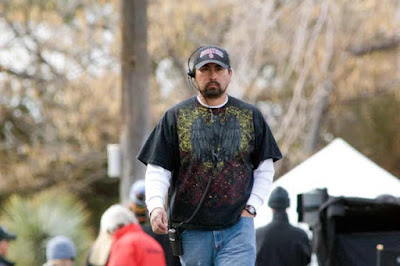 My activity attracted attention and this heavily tattooed man came over. For all his looks, he was a mild mannered messenger; “You can’t take pictures,” he said.
My activity attracted attention and this heavily tattooed man came over. For all his looks, he was a mild mannered messenger; “You can’t take pictures,” he said.“It’s a public park,” I responded.
“It’s a copyrighted production,“ he said.
“What you put on film of your actors is copyrighted, what you do, as a film production crew, in a public park isn’t,” I said.
He wandered off, returning a few minutes later to ask if this was my residence about the same time my mailman came by greeting me by name. I told the assistant that if I got into their scene to let me know because I didn’t want to disrupt their production.
A few minutes later a group of grips put up a 15-foot by 15-foot reflector/screen to block my view.
Then they took a lunch break.
I came back an hour later with my Reflex-Nikkor 500mm f/8 catadioptric lens with a two-time tele-extender.
A production guy walked by on the sidewalk, looked at me and called in on his walkie-talkie, saying, “he's shooting with a short lens, don't worry.”
Ok, so it's the equivalent of 1,500mm on a 35mm piece of film. The 500mm rig is a third the length of the 800mm; it isn't all that sharp, but I got something.
 Back in November, I stopped by the Gibson Medical Center Pharmacy to pick up a prescription.
Back in November, I stopped by the Gibson Medical Center Pharmacy to pick up a prescription.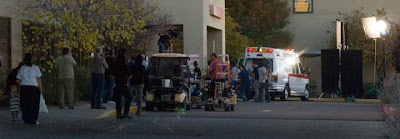 Breaking Bad, another locally filmed television show was shooting at the abandoned Emergency room and entryway.
Breaking Bad, another locally filmed television show was shooting at the abandoned Emergency room and entryway.“You should be discrete with your photography,” Key Assistant Location Manager Roderick Peyketewa said, walking up to me.
“I thought I was.”
“I caught you,” Peyketewa said.
I certainly wasn’t trying to hide, though I didn’t walk up close to where some bystanders were.
Our conversation was then about the need of the production company being able to maintain their storyline from the fans of the show. He said that the paparazzo often shot scenes the production crew wished remained secret until the episode aired.
Standard response, it’s a public place. He shrugged and said I’m sure you’re a fan.
I admitted I didn’t watch the show. Peyketewa wandered off.
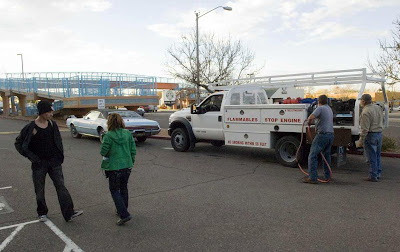 I had an interesting discussion with another production assistant who was making sure that people passing by didn’t inadvertently walk though a camera shot. She talked with actor Aaron Paul, left, who plays character Jesse Pinkman while a movie prop car was refueled.
I had an interesting discussion with another production assistant who was making sure that people passing by didn’t inadvertently walk though a camera shot. She talked with actor Aaron Paul, left, who plays character Jesse Pinkman while a movie prop car was refueled. Another Hollywood myth:
Another Hollywood myth:It doesn’t have to be, it only has to look like it is.
 I’m not Felice Quinto, nor one of his aliases, from the 1960 Federico Fellini, directed movie, La Dolce Vita. Quinto, who passed away recently, was the model for the character of a 1950s tabloid photographer in Rome named Paparazzo. What Paparazzo did in the movie was stalk celebrities and royals in public places. Now Paparazzi is a name that is used with contempt and disdain for many photographers. However, it is not always accurately applied. Many celebrities crave the attention even while complaining about the photographers.
I’m not Felice Quinto, nor one of his aliases, from the 1960 Federico Fellini, directed movie, La Dolce Vita. Quinto, who passed away recently, was the model for the character of a 1950s tabloid photographer in Rome named Paparazzo. What Paparazzo did in the movie was stalk celebrities and royals in public places. Now Paparazzi is a name that is used with contempt and disdain for many photographers. However, it is not always accurately applied. Many celebrities crave the attention even while complaining about the photographers.The banks of photographers at red carpet events are not Paparazzi. Taking pictures from 150 yards away of a movie set of the film crew in a public park does not make me a stalker or a Paparazzi.
It is foolish thinking that something happening in my park won't get photographed for my personal project "from my porch."
McCormack recently made herself an item of local news interest when she made a comment about Albuquerque on a December 29th 2009 E! Network cable talk show, Chelsea Lately, which is billed as a comedy. McCormack later apologized by saying she loved Albuquerque, her home for the past four years.
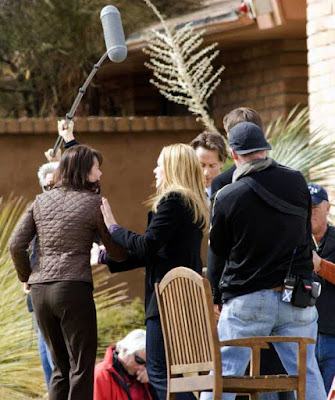 I could post Paparazzi like pictures of McCormack with her two cute small children, whom she talked about on the TV show, playing on the prop swing set, between takes, but I won’t. I'll just show her working.
I could post Paparazzi like pictures of McCormack with her two cute small children, whom she talked about on the TV show, playing on the prop swing set, between takes, but I won’t. I'll just show her working. This post is not about the stars particularly; my interest is political from the tax relief standpoint that the film industry is receiving from our state.
This post is not about the stars particularly; my interest is political from the tax relief standpoint that the film industry is receiving from our state.Gov. Bill Richardson pushed legislation through the State legislature giving the film industry a 25 percent off-the-top tax-rebate. There is also a 50 percent reimbursement for on-the-job training salaries.
The question is whether 25 percent is an appropriate tax break for the film industry. New Mexico had the largest state supported tax initiatives of 30 states offering aid and competing for film productions.
There are various arguments about the return to the state on their tax investments.
 Rep. Dennis Kintigh, left, R - Chaves, Lincoln, and Otero Counties, has twice introduced legislation that would repeal the film production tax credit. In the 2009 Regular Session, it was HB 725, which died after the action was postponed indefinitely and in the 2009 Regular Session it was HB 52, which died without being heard in the House Labor and Human Resources Committee.
Rep. Dennis Kintigh, left, R - Chaves, Lincoln, and Otero Counties, has twice introduced legislation that would repeal the film production tax credit. In the 2009 Regular Session, it was HB 725, which died after the action was postponed indefinitely and in the 2009 Regular Session it was HB 52, which died without being heard in the House Labor and Human Resources Committee.There have been dueling studies with widely varied conclusions.
An August 26, 2008 New Mexico State University Arrowhead Center, Office of Policy Analysis report, “The Film Industry in New Mexico and The Provision of Tax Incentives,” by Anthony V. Popp and James Peach was submitted to the Legislative Finance Committee.
The report found:
25% Production Rebate: During fiscal year 2008 the NM government granted $38.195 million in rebates. The resulting increase in economic activity generated $5.518 million in revenues. The implied return is 14.44 cents on the dollar. This means that for every one dollar in rebate, the state only received 14.44 cents in return.An “Economic and Fiscal Impacts of the New Mexico Film Production Tax Credit,” was an analysis prepared for the New Mexico State Film Office and State Investment Council by Ernst and Young in January 2009.
The report found:
State and local return on investment from 2007 and future tax revenues attributable to 2007 film productions, (was $1.50 on the dollar).Legislative Finance Committee Chief Economist Norton Francis wrote a revised memo analyzing and comparing the finding of the Ernst and Young and the NMSU reports. Francis revised both numbers to have a return on investment to be 93 cent on the dollar.
The New Mexico film industry has sunk a fair amount of capital into the construction of Albuquerque Studios, the single largest studio complex, at 54 acres, on Mesa del Sol.
Local colleges, Central New Mexico and College of Santa Fe have film programs.
The concerted effort of the State and City of Albuquerque’s film offices has had an affect of making the state sought after location for filming, according to Movie Maker.com.
There are a lot of people employed on these film sets. I happened to find several “call sheets” which are the game plan for a day’s shooting with all the necessary personnel. The most telling way of knowing how many people are actually on a set is to look at the catering order. On the Breaking Bad set there were 150 breakfasts and lunches ordered.
 Most of the set work is part time, but those employed infuse their income into the local economy and tax base. A production assistant carries two trays of coffee from the local Starbucks for her fellow workers.
Most of the set work is part time, but those employed infuse their income into the local economy and tax base. A production assistant carries two trays of coffee from the local Starbucks for her fellow workers.During the current budget crisis, legislators prior to the 30-day session, briefly discussed revisiting the film tax rebate, but it was quickly dismissed.
 My Take
My TakeWhat I find so bizarre, is one group of photographers – filmmakers – recording a dramatic performance believing that they can prohibit another photographer from engaging in the same activity in the same public place; then calling me a disparaging name. Yet the audacity is compounded by the fact that they get a 25 percent off-the-top as a tax-break.
Yeah, right....
 I’ve taken pictures of movie making for years. In 1969, I photographed this crew across from the United Nations while they shot from the top of a rental moving van.
I’ve taken pictures of movie making for years. In 1969, I photographed this crew across from the United Nations while they shot from the top of a rental moving van.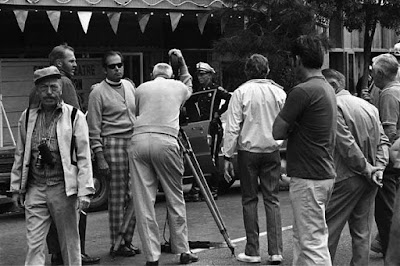 This is Gerd Oswald, left, directing the movie, Bunny O'Hare, downtown in 1971. The movie stared Academy Award winners Bette Davis and Ernest Borgnine.
This is Gerd Oswald, left, directing the movie, Bunny O'Hare, downtown in 1971. The movie stared Academy Award winners Bette Davis and Ernest Borgnine.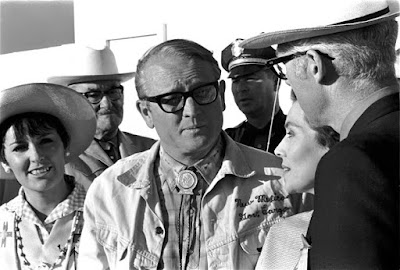 Gov. David Cargo, center, seen during the 1970 Republican Governors Conference in Santa Fe, played a State Trooper in the movie. He had concentrated on attracting movies to New Mexico through his newly established New Mexico Development Commission. A while back Cargo told me he still maintained his Screen Actors Guild membership.
Gov. David Cargo, center, seen during the 1970 Republican Governors Conference in Santa Fe, played a State Trooper in the movie. He had concentrated on attracting movies to New Mexico through his newly established New Mexico Development Commission. A while back Cargo told me he still maintained his Screen Actors Guild membership.Oswald invited the public to watch as he worked on Central Ave. downtown. He also invited the press onto the set.
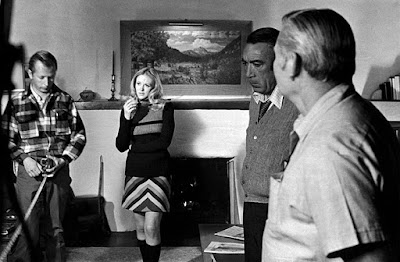 The same year, another Academy Award winner, Anthony Quinn, second from the right, played Mayor Thomas Jefferson Alcala with actress Skye Aubrey as Sabina Menard, on the set of, “The City,” a 2-hour pilot made for ABC TV. A series set in Albuquerque followed, renamed, “Man and the City.”
The same year, another Academy Award winner, Anthony Quinn, second from the right, played Mayor Thomas Jefferson Alcala with actress Skye Aubrey as Sabina Menard, on the set of, “The City,” a 2-hour pilot made for ABC TV. A series set in Albuquerque followed, renamed, “Man and the City.”The set was the interior of a Corrales home. As an Albuquerque News photographer, I was invited to take a few photographs.
 The world has changed. Where giving publicity to the film industry was once openly welcomed, now production assistants attempt to assert control over their little world through confrontation and mild intimidation.
The world has changed. Where giving publicity to the film industry was once openly welcomed, now production assistants attempt to assert control over their little world through confrontation and mild intimidation.Maybe they know just how much the governmental incentives are worth and don’t want anything that might question or threaten them to expose their good deal.
7 comments:
Sir,
As someone who's spent over 40 years working in 'the biz' I'd like to offer you a sincere apology for the way you've been treated on behalf of all of the New Mexicans who're now making a living by working in the motion picture business. While quite obviously this wasn't apparent, most of us are keenly aware that not only do our livelihoods depend on the companies we work for being able to use of locations such as your park but that this is entirely dependent upon our treating both those physical locations and the people who reside in and around them with respect - at all times and irrespective of any other job related imperatives. Frankly one of the worst things about the cannibal village of 'Hollywood' is the way that the people who live there habitually treat one another, which I suppose stems from their living in a world where everyone and everything is measured by its ability to serve their own immediate and inherently selfish needs - which unfortunately is an attitude they seem to have brought with them into your neighborhood. Anyway I sincerely regret what took place and am doing what I can to bring the incidents you mentioned to the attention of the other members and leadership of IATSE local 480 in the hope that this sort of thing won't reoccur, not only to you but to anyone else.
Describing Hollywood as a 'cannibal village' is a bit strong but the members of that tribe tend to be insular and as a result may at times appear to be hostile, particularly when their rituals are intruded upon. None the less it seems to me that, as the Captain of Road Prison 36 said in Cool Hand Luke (1967), "What we got here is... failure to communicate".
That being the case, let's start with the way that appearances influenced the outcome of these incidents. Setting aside your natural response to a stranger who looked like a criminal wandering into your neighborhood in search of trouble, with all of your professional photographic equipment and long lenses you inadvertently resembled a 'paparazzi' rather then an ordinary citizen with his point and shoot camera, and this apparently triggered the defense mechanism of someone who's responsibilities may have included insulating and protecting the talent from intrusions, since (quite apart from any nonsense about activities taking place in a public space being afforded some kind of copyright protection), some paparazzi have been involved in stalking incidents, pursuits and confrontations resulting in injuries and as a result are generally regarded as being predators.
In any case a motion picture location isn't a crime scene and no matter what sort of apprehensions anyone who was working for those productions and/or 'stars' might have had, they had no right to prevent you from being where you were or taking photographs. Unfortunately it seems that in both the circumstances you described no one had the authority (or wits) to respond once you'd been in effect checked out, by simply asking you "hey, how about a cup of coffee" and then bringing you into their encampment, which might have left you with a much better experience (and impression of the motion picture business in New Mexico) then what you received.
That's what I'd hope to be able to do if I'm ever working in your neighborhood - but then I'm only an old grip.
Frankly one of my recurring nightmares involves discovering a film crew in my house so I can certainly appreciate what a shock it must have been for you to find them swarming just across the street, particularly since New Mexico producers usually make an effort to give local residents some warning.
Anyway, there's a couple of things that I'd like to bring to your attention regarding the N.M. film production tax incentives.
First of all the 25% refund is only applied to the state taxes on the goods and services which qualified production companies have already purchased in New Mexico. Also under a new policy that was instituted in 2009, production companies who wish to use New Mexico's tax credit will be required to provide the New Mexico Film Office with detailed information regarding the expenses they submit in order to qualify for the credit. Previously this data was only provided to the Taxation and Revenue Department, where it was kept confidential. So at the conclusion of F/Y2010 the Film Office will begin to be able to provide the public and our legislators with aggregate totals in specific categories for all film and television productions. The categories that will be reported include the total dollar amount spent in New Mexico and the total amount spent on New Mexico crew, talent, facilities and property rental, lodging, food, rental vehicles, equipment, construction costs, set dressing, wardrobe and special effects/props.
Apart from all of that I'd also like to apologize for the way you were treated because even though film crews and their employers are usually under a lot of pressure to get their work done there was no reason that I can see for them to have been so rude.
I don't intend this to in any way excuse what took place but there's a perceptible difference to the way that the producers of motion pictures and TV series operate, with the latter generally having a reputation for being more inflexible and mean because of the sort of deadlines they operate under. None the less, because of the kind of intense personal focus that's required to perform the various tasks involved in filmmaking the people who do this kind of work tend to be forced into a sort of tunnel vision, which unfortunately can produce not only a certain kind of blindness and loss of perspective but also the sort of arrogance and callousness that you were the recipient of.
In any case, the film business and everyone who's benefiting from it taking place in New Mexico are in fact absolutely dependent on the ability of the filmmakers and their crews to create and maintain a good relationships with the general public, which at the very least is a matter of their making an obvious effort to intrude as little as possible into our daily lives. For the most part it seems this is the case, but all it takes for most people is a single incident in which they're treated disrespectfully to turn them against this industry, which in the aggregate could have a profound effect when it comes to the sort of political support it will take to keep the film production incentive programs in place that are generating the sort of economic and fiscal benefits which we as New Mexicans are currently taking advantage of.
Back in July of 1986 a motion picture scout wandered into the Plaza del Cerro here in Chimayó and started taking pictures. Nobody paid much attention to that since he looked like just another tourist in a Hawaiian shirt who'd strayed from the Ortega's Weaving shop - until Mrs. Martinez, who was at least 80 years old at the time, came roaring out of her house and started yelling at him to get off her property. Turned out he'd moved a bench that was next to her front door and then stood on it in order to stick his camera up to her bathroom window and take a shot of the interior of the house with a strobe, which caught her in the midst of taking a bath.
As if that wasn't bad enough, when her son (who was a high school principal) turned up and asked the photographer for the roll of film he'd used, the fool not only refused but apparently went off like a speed crazed rat about how the plaza was public property (which it isn't, apart from a single lane dirt road that goes through it ) and that 'you people' should be glad that Robert Redford was going to be making a movie in Chimayó.
This was more then enough to get everyone stirred up, but by the end of the day when this arrogant Hollywood bozo had finished cutting a wide swath through town, the entire community was up in arms and there wasn't a chance in hell that Redford would ever shoot here.
However to his credit Redford later held a public meeting and after failing to convince the assembled throng of angry Chimayósos that everything would be ok, respectfully congratulated us for standing up for our beliefs, after which he moved on to shoot up in Truchas (http://articles.latimes.com/1986-07-20/entertainment/ca-16874_1), which over the course of 18 weeks of production ended up costing him a lot of extra time and money.
In fact all it would have taken to prevent all of this would have been just a little sensitivity, some common sense and a measure of respect, all of which incidentally were very much in evidence when the producers of "Spoken Word" (http://www.imdb.com/title/tt1212443/) were filming here last year. They not only went out of their way to let us know what they were doing well before they started shooting but were also very responsive to our community's needs, for instance by altering their schedule so the road through Chimayó wouldn't be blocked when people were trying to get to work and also when the kids would be coming home from school on their buses. Simple things like that made a huge difference, as did their hiring a lot of local people and purchasing their construction and other materials locally.
As the saying goes, "what goes around comes around", and I'd suggest this is something that film companies need to recognize if they want to work in our neighborhoods.
I see that Senate President Pro Tem Tim Jennings (D-Roswell) is now saying that if the Governor vetoes the food tax he should cut tax incentives for the film industry to make up the difference because "These are benefits that go to people from out of state”
(http://newmexicoindependent.com/49605/cut-film-credits-to-fill-food-tax-veto-hole-jennings-says).
Senator Jennings knows this isn't the case since every time he's introduced legislation that was intended to cut or eliminate our state's film production tax incentives during the last three legislative sessions, New Mexican film workers, representatives from the four local trade unions that represent them (over 4,000 members) and the state Film Office, along with owners of local businesses that provide services to the industry and representatives from trade associations for other NM businesses (that among other things provide lodging, meals, materials and rental vehicles and construction equipment to filmmakers) have presented him with substantive information concerning the overall economic impact and fiscal benefits to New Mexicans that result from our using tax incentives to draw the film industry to New Mexico.
Senator Jennings and the Legislature were also on those occasions provided with expert testimony that showed how production activity now takes place in direct proportionate to the amount of incentives available and the extent to which the level of activity which our state's incentive program has created would decline as a result of cutting the state's incentives due to a shift of film and TV production activity to other states that offer industry incentives. In fact the production industry is now highly mobile, so within days of an announcement early last year that NY had run out of tax credits, production companies began looking elsewhere and ceased to work in that state. The resulting job losses,
increase in unemployment claims, loss of economic activity and decline in tax revenues that were directly attributable to the loss of production incentives caused the New York legislature to then enact a $350 million expansion of their incentives.
I suppose the thing which is most confounding about the repeated efforts that Senator Jennings and Smith have been making to cut or eliminate New Mexico's production incentives is that their concept of the state being able to somehow recapture 'unrealized revenue' by cutting the incentives that create this revenue possible is at best counter intuitive. In fact there's every indication that cutting the incentives would result in fewer goods and services being purchased in New Mexico and that this would correspondingly effect the amount of tax revenue resulting from this activity, as well as that which would otherwise be derived from the associated increases in economic activity that the presence of this industry in N.M. provides.
Unfortunately there are those who continue to insist that this is just conjecture and the information concerning the economic and fiscal impacts of the state's film production tax credit which was prepared for the Film Office and State Investment Council is flawed. However it seems to me that even if there was some short-term gain to be had by attempting to recapture unrealized tax revenue by cutting the film incentives, taking the larger risk of our losing an industry (which happens to one of the few in the U.S. providing an export surplus) that's growing and prospering in our state when many of our other businesses and industries are struggling, is completely nuts.
After reading this commentary I have a few questions. First of all, what other industry that operates in our state is currently hiring and training large numbers of New Mexicans for jobs which pay salaries that are above average for this area and also provide full benefits, also are there any other industries which have generated hundreds of locally owned businesses in the way the film industry has over the last couple of years. I'd also like to know how it is that we're 'giving money away' if the state ended up getting $325 million by using $82 million of tax incentives to bring an industry into New Mexico which ended up having a total economic impact of perhaps $689 million dollars. Also, considering that our tax incentives have resulted in New Mexico managing, in the face of fierce competition from 42 other states and 15 countries, to become fourth in terms of the amount of film production in the US (and the 3rd best location for film production in North America according to the industry trade magazine Variety), why would we want to suddenly abandon our share of a 15 billion dollar industry in order to attempt to recapture tax revenues, particularly since those revenues will diminish or cease to exist if the incentives that create them are capped or eliminated.
Considering the arguments over the amount of the fiscal and economic benefits created by using film production tax incentives to encourage this form of economic development in New Mexico, I found it interesting that during the last regular legislative session when Senator Keller introduced Senate Bill 47, which was intended to provide legislation intended to add economic impact reporting requirements (including tracking jobs created) for all of the state's $700 million worth of economic incentives (at least 30 are “give and forget” to various interests and companies), the N.M. film workers and their trade unions supported this measure, unlike the two Senators (and Rep. Kintigh) who for some time have been advocating capping and/or eliminating the incentives for film production, largely on the basis of lawmakers not having the information they need to see the impact of that particular industry on the state. None the less, over their objections SB 47 was passed by the House and Senate and as a result is now awaiting the Governor's signature or veto.
Post a Comment